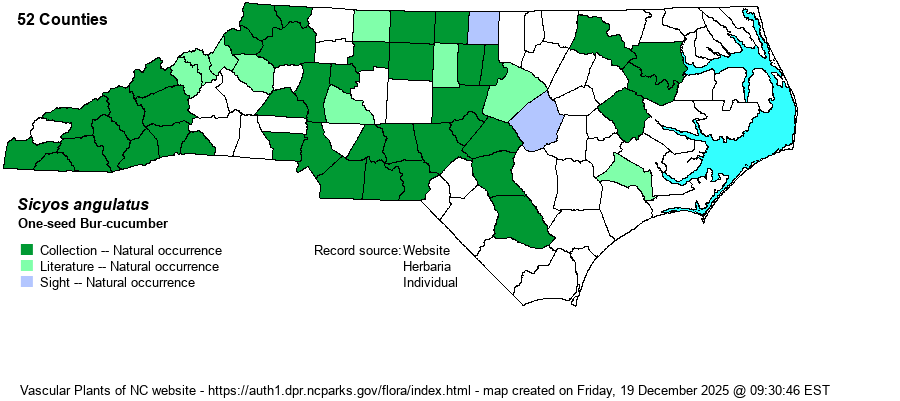| Author | L. | |
| Distribution | Present over most of the Mountains and Piedmont, as well as parts of the western and central Coastal Plain (though mostly along brownwater river floodplains there).
This species has a broad Eastern range, occurring from ME and ND south to northern FL and central TX.
| |
| Abundance | Infrequent to locally fairly common (along larger brownwater rivers) in the Mountains and Piedmont; generally rare to locally uncommon in the western and central Coastal Plain, where limited mainly to the Roanoke and Cape Fear rivers. Absent from the coastal region of the state. | |
| Habitat | This is a wetland species, found essentially in rich bottomlands, almost strictly in brownwater situations. It grows in openings and along margins of bottomland forests and in damp thickets. | |
| Phenology | Blooms from August to frost, and fruits shortly after flowering. | |
| Identification | This is a robust herbaceous vine, climbing to about 8-9 feet long. The leaves are alternate and somewhat large, having 3 principal triangular lobes, with small side lobes; the leaf base is broadly cordate. Each leaf, somewhat resembling those of many grape (Vitis) species, is about 5-6 inches wide and long. A long tendril and a tight cluster of male or female flowers, on a long stalk, are opposite each leaf. The male flowers and female flowers are somewhat similar, being white to cream, with 5 triangular lobes and a spread of about 2/3-inch -- quite star-shaped. The fruits are in tight clusters, each bur-like with spines and ovoid in shape, about 1/2-inch long. Note that the somewhat similar Echinocystis, of the New River floodplain in NC, has a single large bur, over 1-inch long, instead of a cluster of smaller burs; and that species has 6-parted flowers instead of 5 in Sicyos. | |
| Taxonomic Comments | None
| |
| Other Common Name(s) | Bur-cucumber, Star-cucumber | |
| State Rank | S3 [S4] | |
| Global Rank | G5 | |
| State Status | | |
| US Status | | |
| USACE-agcp | FACW link |
| USACE-emp | FACU link |

